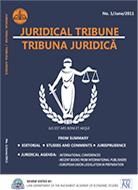International arbitration and its exclusion from the Brussels regime
International arbitration and its exclusion from the Brussels regime
Author(s): Hamed Alavi, Tatsiana KhamichonakSubject(s): Law, Constitution, Jurisprudence, International Law
Published by: Societatea de Stiinte Juridice si Administrative
Keywords: international arbitration; litigation; the EU law; Brussels regulation; Brussels recast; K11; K20; K30
Summary/Abstract: The Brussels regime, which regulates the matters of transnational litigation excludes arbitration from its scope. Upon formation of the Brussels regime the existing instruments concerning arbitration - the United Nations Convention on Recognition and Enforcement of Foreign Arbitral Awards and the 1961 European Convention on International Commercial Arbitration - were believed to be sufficient. The original Brussels Convention 1968 on recognition and enforcement of judgments delivered in the courts of the EU Member States expressly provided for the exclusion of arbitration. The following Brussels I Regulation3 followed the trend and reinforced the exclusion of arbitration from their material scopes. The rationale for doing so was primarily the prevention of parallel proceedings and irreconcilable judgments. The arbitration exclusion from the Brussels regime has caused a fair amount of confusion, especially regarding the extent and limits of the exclusion. That is, whether the arbitration agreement, the arbitral award and its consequences are covered by the exclusion or they may fall under the scope of the Brussels regulation if they constitute only an incidental question to the main cause of action?4 The confusion was illustrated in the ECJ judgment West Tankers5, which generated negative feedback from the arbitration community and indicated the need for reform. The recently adopted Recast Regulation6 took it upon itself to clarify the relationship between arbitration and the EU regime of transnational litigation. The exclusion is reinforced yet again and its boundaries are specified in the Preamble. However, whether or not the concerns about the extent and objectives of arbitration exclusion have been at present eliminated, remains to be seen.
Journal: Tribuna Juridică
- Issue Year: 6/2016
- Issue No: 11
- Page Range: 7-26
- Page Count: 20
- Language: English

